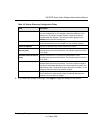
GS700TR Smart Switch Software Administration Manual
4-14 Configuring Routing
v1.0, May, 2008
Configuring ARP
The address resolution protocol (ARP) associates a layer 2 MAC address with a layer 3 IPv4
address. GS700TR Smart Switch software features both dynamic and manual ARP configuration.
With manual ARP configuration, you can statically add entries into the ARP table.
ARP is a necessary part of the internet protocol (IP) and is used to translate an IP address to a
media (MAC) address, defined by a local area network (LAN) such as Ethernet. A station needing
to send an IP packet must learn the MAC address of the IP destination, or of the next hop router, if
the destination is not on the same subnet. This is achieved by broadcasting an ARP request packet,
to which the intended recipient responds by unicasting an ARP reply containing its MAC address.
Once learned, the MAC address is used in the destination address field of the layer 2 header
prepended to the IP packet.
The ARP cache is a table maintained locally in each station on a network. ARP cache entries are
learned by examining the source information in the ARP packet payload fields, regardless of
whether it is an ARP request or response. Thus, when an ARP request is broadcast to all stations
on a LAN segment or virtual LAN (VLAN), every recipient has the opportunity to store the
sender’s IP and MAC address in their respective ARP cache. The ARP response, being unicast, is
normally seen only by the requestor, who stores the sender information in its ARP cache. Newer
information always replaces existing content in the ARP cache.
The GS700TR switches support 480 ARP entries.
Devices can be moved in a network, which means the IP address that was at one time associated
with a certain MAC address is now found using a different MAC, or may have disappeared from
the network altogether (i.e., it has been reconfigured, disconnected, or powered off). This leads to
stale information in the ARP cache unless entries are updated in reaction to new information seen
Next Hop IP Address The outgoing router IP address to use when forwarding traffic to the next
router (if any) in the path towards the destination. The next router is always
one of the adjacent neighbors or the IP address of the local interface for a
directly attached network.
Preference Shows the preference value for the configured next hop.
Table 4-7. Route Status Fields (continued)
Field Description


















